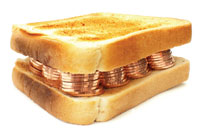The many layers of VAT
 VAT can easily give even the most seasoned of tax experts a headache, and the fact that European Union VAT rules take precedence over UK law just adds to the complexity.
VAT can easily give even the most seasoned of tax experts a headache, and the fact that European Union VAT rules take precedence over UK law just adds to the complexity.
Take the simple matter of buying a sandwich, which is not that simple when it comes to VAT. When you buy a sandwich from a sandwich shop or other fast food retailer it will cost you more to eat it on the premises because you’ll be charged VAT.
HMRC’s VAT notice covering catering and take-away food states that a ‘supply made in a restaurant or similar establishment’ is subject to VAT because it is a ‘supply in the course of catering’.
There is an exception for cold take-away food – hot take-away food is VAT-able. However, the European Court of Justice (ECJ) recently ruled that where the level of service involved is minimal, then VAT should not be charged on cold food sold for immediate consumption, even if ‘eaten in’. Sandwich chain Subway has filed a test case against HMRC, and many other retailers are expected to follow suit.
Subs and chickens
Subway is also involved in the continuing fallout from the ‘pasty tax’. The tax charge on pasties was dropped, but toasted sandwiches are still subject to VAT. Subway hopes to have the issue debated in Parliament, and has recently appealed a 2010 case decided in HMRC’s favour.
Subway argued that its sandwiches must be served toasted in order to comply with food safety regulations. The decision again went HMRC’s way, but Subway may take the case to the Court of Appeal.
Not to be outdone, Morrisons supermarket is organising a campaign to reverse the 20% VAT charge that now applies to rotisserie chickens. The company argues that the majority of its customers make purchases to eat later, rather than as take-away food. Food left to cool down avoids the new VAT charge, but rotisserie chickens cannot be left to cool for food safety reasons.
The outcome of another conflict between UK and EU law means that businesses may now be able to claim VAT refunds on bad debts going back nearly 40 years. Nowadays, VAT bad debt relief can generally be claimed once a debt is more than six months overdue, but the conditions were once much stricter – the customer had to be insolvent, and a retention of title clause precluded any relief.
In a case brought by BT and General Motors’ finance arm, the Tribunal ruled that the conditions previously imposed were not compatible with EU law, and that the normal four-year time limit was not applicable.
This means that refunds can be claimed for the period between 1973 (the year VAT was introduced) and 1997 (when VAT bad debt relief rules were rewritten). Given the amounts involved, HMRC is likely to appeal, possibly to the ECJ. We can help with a submission of a historic bad debt relief claim if your business is due a refund, although one practical difficulty could be finding the documentation after all this time.
Carbon emissions and the EU
If all of that isn’t enough, there is one other conflict that could well end up in the ECJ. As part of its drive to reduce carbon emissions, the Government introduced a reduced rate of VAT of 5% for energy efficient products, such as draught insulation and solar panels.
The European Commission has said that such a supply is beyond the range of items for which the reduced rate is permitted by the EU VAT directive, and therefore the standard rate of 20% should be charged instead. The Government disagrees with the Commission’s findings, but will study the arguments before deciding on how to proceed.
 Following the European Court of Justice’s ruling that insurers cannot charge different premiums based on gender, did you know that from 21 December 2012 pension providers must use the same rates for women as for men when determining the maximum pension that can be taken as drawdown? The change will not initially affect men, but women can take a higher drawdown pension than before. For example, HMRC calculates that annual drawdown for a 60-year-old woman with £100,000 invested could rise from £5,000 to £5,300. But in the longer term, the ruling is likely to result in an overall reduction in annuity rates.
Following the European Court of Justice’s ruling that insurers cannot charge different premiums based on gender, did you know that from 21 December 2012 pension providers must use the same rates for women as for men when determining the maximum pension that can be taken as drawdown? The change will not initially affect men, but women can take a higher drawdown pension than before. For example, HMRC calculates that annual drawdown for a 60-year-old woman with £100,000 invested could rise from £5,000 to £5,300. But in the longer term, the ruling is likely to result in an overall reduction in annuity rates.